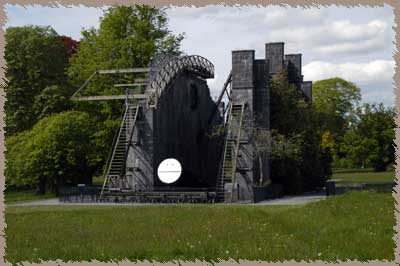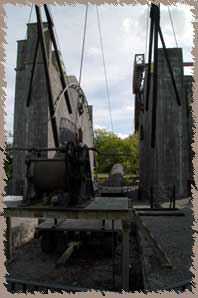
Details
Cº Offaly
Birr Castle Demesne
open daily summer
0900-1800
open daily winter
1000-1600
€7
Miscellaneous Photos
Photos
neolithic sites
abbeys and churches
castles
dublin
waterford
round towers
lovely scenics
Links
travelogueBirr Castle Demense
Telescope HIstory

the Ross Telescope on the grounds of Birr Castle
 Wandering through the grounds of Birr Castle (the castle itself is not open, but the gardens and the grounds are spectacular!) you come across this -- an enormous, fixed telescope. It's rather odd to find this enormous metal and timber structure in the gardens.
Wandering through the grounds of Birr Castle (the castle itself is not open, but the gardens and the grounds are spectacular!) you come across this -- an enormous, fixed telescope. It's rather odd to find this enormous metal and timber structure in the gardens.
 looking through the supporting walls of the telescope
looking through the supporting walls of the telescope
The telescope is the work of the third Earl of Ross, Lord Oxmantown, who was the president of the British Royal Society btween 1848-1854. . The telescope was built in 1845 and remained one of the largest telescopes in the world until nearly 1950. The reflector is 72" in diameter, which required that the Earl of Ross develop new technologies to grind the mirrors properly. The mirror is metal, not glass, as there existing no method to cast glass in the sizes ncessary for the telescope.
He first built a 36" reflector telescope, which was completed in 1839. The mirror was cast and ground at the castle, but it was of such high quality that it was able to view stellar objects with previously unknown clarity. It magnified the moon by roughly 900x, which allowed the Earl to create detailed maps of the moon's surface, and indeed, to estimate its temperature (although I don't honestly know how that was accomplished!)
THe larger telescope here was built over 3 years, and was known locally as "The Leviathan". The tube for the telescope is 58 feet long and is supsended between two 15m walls. Using a complex system of pulleys and tracks, the telescope can be raised from about 15 degrees to nearly vertical. The telescope can shift only a little from left to right, but it is easily moved vertically. This means that the operator could look at the motion of an object in th4 sky from 1-2 hours, depending on how high it was sin the sky. This larger telescope magnified the moon roughly 6500x.
The Earl was able to view many spiral nebulae and even was able to resolve that some of the nebulae were not just gas clouds, but contains objects. This discovery was advanced by Edwin Hubble in 1923, who showed that nebulae were indeed galaxies that were often larger than our own. Unfortunately, the telescope was too unsteady to provide a stable base for photographs at the time (which often required explosures of several minutes). However, the discoveries made through this telescope were to lead astronomers to even more detailed views of the skies.
The telescope was used by the fourth Earl in the 1880s to perform the first accurate mapping of the moon, as well as nearby spiral nebulae. The current mirror is a replica, the original is in London's Science Museum (where it was moved when the Troubles began in Ireland in 1914).

the small brass viewfinder on the 72" telescope
The telescope fell into disrepeat after 1908 (the death of the fourth Earl), and all the metal surrounding the telescope and used for its supports was metled down to be used in WWI. The wooden parts of the telescope were removed in 1925.
However, there was a complete restoration effort was undertaken between 1996 and 1998. Using photographs, original drawings, and other engineering documents, they rebuilt the telescope to its original specifications. The original universal joint of the telescope was retained (it was still fine!). However, this is more of a recontruction of the original, not restoration, as most of the original pieces were destroyed and the new versoin uses newer technologies to reduce weight. For example, the new tube is 90% lighter than the original, since it uses steel framing and not only timber.